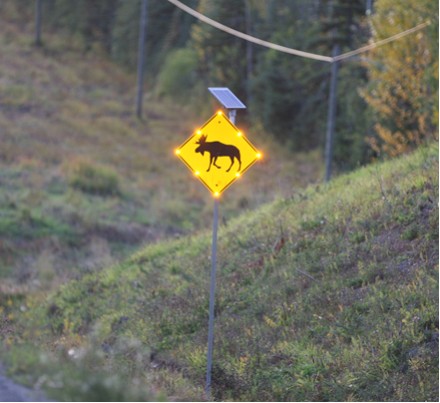Moose Collision Signs Stolen
By 250 News
Thursday, July 02, 2009 11:55 AM

Prince George, B.C.- The Wildlife Collision Prevention Program reports that two high intensity LED moose collision warning signs located east of Prince George, on Highway 16, were stolen in early April.
The signs (located near the moose viewing site by the base of the Tabor Mountain ski hill) marked a high risk location for moose collisions. The site has a mineral lick on the north side of Highway 16.
Drivers are urged to exercise caution driving in the area, particularly during the month of July. There is a traditional peak of moose activity in July on Prince George area highways. “Moose crave mineral soils during late June and July because of nutritional demands caused by calving, nursing and antler growth,” says Roy Rea, moose biologist, University of Northern British Columbia. “They seek out mineral or muck licks that are often located in highway rights-of-way.”
These two signs were part of a moose collision prevention initiative being implemented in north central B.C..
The signs were funded by ICBC’s Loss Prevention Program and were worth approximately $4,000.00. “It will be difficult to find the funding to replace these signs,” says Barb Waters, Regional Manager, BC Conservation Foundation, a non profit society.
There is a mixed jurisdictional issue in this issue.
The Ministry of Environment is responsible for the management of the moose population, the Ministry of Transportation is responsible for the highways and ICBC is responsible for loss prevention.
“This is a dangerous area, and needs to be signed” says Gayle Hesse, Coordinator of the Wildlife Collision Prevention Program.
The signs, which displayed the traditional black and yellow moose silhouette, outlined by bright, high intensity flashing LED lights, were extremely visible during both day and night. “We had lots of calls from people who said they had noticed the signs” adds Hesse, who says the sign was effective because it called on drivers to be extra cautious on a relatively short stretch of highway.
The signs were put in place in December 2007, and since then only one wildlife collision has been recorded in that location. From 2003 until the sign was installed in December 2007, seven animals had been killed in that location.
Wildlife Collision Facts:
· On average, there are two people killed in wildlife related crashes in north central BC every year (5 year average; 100 Mile House to BC/Yukon border).
· On average, 138 people are injured in animal-related crashes in north central BC every year (5 year average; 100 Mile House to BC/Yukon border).
· On average, there are 3,194 animal related crashes in north central BC every year (5 year average; 100 Mile House to BC/Yukon border).
· 7 animal carcasses were recovered at this site from March 2003 to November 2007. This is a pre-sign average of 1.5 animals killed every year at this location.
· Only one animal carcass (1 deer killed on Nov. 4/08) has been recovered at this site since December 2007. This is a post-sign average of 0.75 animals killed every year at this location.
· On average 12 moose are killed in July on the highways around Prince George.
· The highest risk time of day for moose collisions in June and July on the highways around Prince George is between 10:00 and 11:00 pm**.
Previous Story - Next Story
Return to Home










